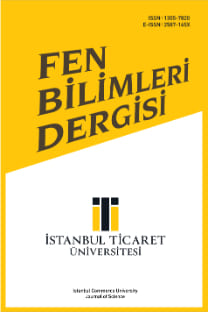PLANLANAN ÖZEL ETKİNLİK KATILIMCILARININ HARCAMA ANALİZİ: İKİLİ LOGİT MODELİ
Anket çalışması, Harcama analizi, İkili logit model, Planlı özel etkinlikler, Yolcu davranışı
EXPENDITURE ANALYSIS OF PLANNED SPECIAL EVENT PARTICIPANTS: BINARY LOGIT MODEL
Binary logit model, Money expenditure, Planned special events, Survey study, Travel behavior,
___
- Abuhamoud, M.A.A., Rahmat, A.R.O.K. & Ismail, A. (2011). Modeling of Transport Mode in Libya: A Binary Logit Model for Government Transportation Encouragement, Australian Journal of Basic and Applied Sciences, 5(5), pp. 1291-1296.
- Cook, R. A., Yale, L. J. & Marqua, J. J. (2010). Tourism: The Business of Travel, Pearson Education Limited: Pearson Prentice Hall. United Kingdom.
- Ergin, M.E. & Tezcan, H. (2022). Joint Logit Model Approach to Analyze Soccer Spectators’ Arrival Time and Location Preferences for Interim Activities in Istanbul. International Journal of Engineering, 35(4), 613-625. http://doi:10.5829/ije.2022.35.04A.01
- Ergin, M.E. (2021). Modelling Travel Demand for Planned Special Events: A Study for Istanbul, Ph.D. Thesis, Istanbul Technical University, Istanbul.
- Hess, S. & Palma, D. (2019). Apollo: a flexible, powerful and customisable freeware package for choice model estimation and application. Journal of Choice Modelling, 32. http://doi:10.1016/j.jocm.2019.100170
- Horowitz, J. L., Koppelman, F. S. & Lerman, S. R. (1986). A self – instructing course in disaggreagate mode choice modelling. (Report no: IA-11-0006.) Department of Geography University of Iowa, Iowa City, USA.
- Kwiatkowski, G. (2016). Economic Impact of Event Attendees’ Spending On A Host Region: A Review of the Research, Event Management, 20, pp. 501–515. http://dx.doi.org/10.3727/152599516X14745497664398
- Lancaster, K. J. (1966). A new approach to consumer theory. Journal of Political Economy, 14 (2), pp. 132-57.
- Latoski, S.P., Dunn, W.M., Wagenblast, B., Randall, J. & Walker, M.D. (2003). Managing travel for planned special events, Department of Transportation, Washington D.C, USA.
- Leilei, D., Zheng-liang, S., Jin-gang, G. & Hong-tong, Q. (2012). Study on traffic organization and management strategies for large special events, in 2012 International Conference on System Science and Engineering (ICSSE), IEEE., 432-436.
- Shen, G. & Wang, J. (2012). A Freight Mode Choice Analysis Using a Binary Logit Model and GIS: The Case of Cereal Grains Transportation in the United States. Journal of Transportation Technologies, 2, pp. 175-188. http://doi:10.4236/jtts.2012.22019
- Skolnik, J., Chami, R., & Walker, M. (2008). Planned Special Events – Economic Role and Congestion Effects, FHWA Office of Operations. Report No: FHWA-HOP-08-022. (Accessed on 10 June 2022).
- TurkStat, (2022). https://data.tuik.gov.tr/Search/Search?text=population&dil=2 (Accessed on 10 June 2022).
- ISSN: 1305-7820
- Yayın Aralığı: Yılda 2 Sayı
- Başlangıç: 2002
- Yayıncı: Doç. Dr. Necip Şimşek
OPTİMUM SIRALAMALI V-BLAST KULLANAN DİKGEN OLMAYAN ÇOKLU ERİŞİM
Furkan KARDAŞ, Mustafa Anıl REŞAT, Serdar ÖZYURT
PLANLANAN ÖZEL ETKİNLİK KATILIMCILARININ HARCAMA ANALİZİ: İKİLİ LOGİT MODELİ
Mahmut Esad ERGİN, Vail KARAKALE
PANDEMİ SÜRECİNDE ÇAĞRI MERKEZİ ÇALIŞANLARININ TÜKENMİŞLİĞİNE COVID-19 HASTALIĞININ ETKİSİ
Samet BABADAĞ, Özlem DENİZ BAŞAR
KİLİSE YAPILARININ DÖNÜŞÜMÜNÜN GAZİANTEP ÖRNEĞİ ÜZERİNDEN İNCELENMESİ
BÜYÜK VERİDE ANONİMLEŞTİRME TEKNİKLERİ VE SALDIRI TÜRLERİ: UYGULAMA ÖRNEKLERİ
Hamza Talha GÜMÜŞ, Can EYÜPOĞLU
ÇEVRE KOŞULLARININ ANITSAL YAPILAR ÜZERİNDEKİ ETKİLERİ
Halil İbrahim SAĞDIÇ, Leyla SURİ
DEMİRYOLU ARAÇLARININ BAKIM MASRAFLARININ RAMS ANALİZLERİYLE DEĞERLENDİRİLMESİ
Hamit Murat GEYİK, Yalçın EYİGÜN
ULUSAL BİLGİ VE İLETİŞİM GÜVENLİĞİ REHBERİ: IoT GÜVENLİĞİ İÇİN BİR UYGULAMA ÖRNEĞİ
